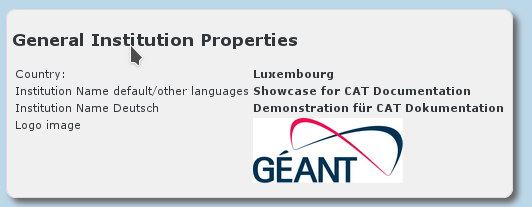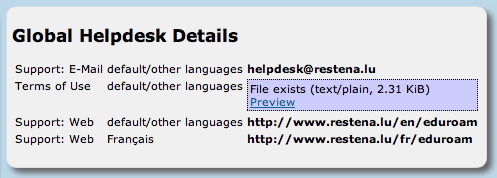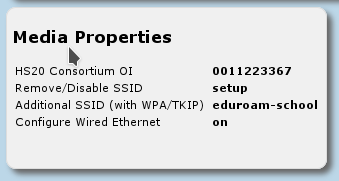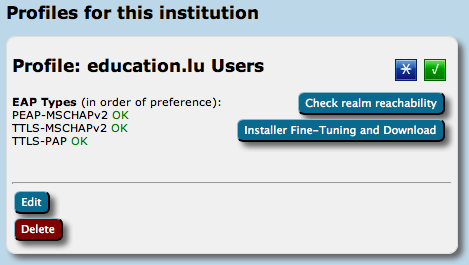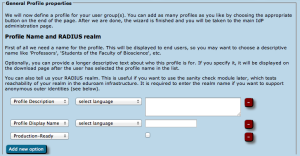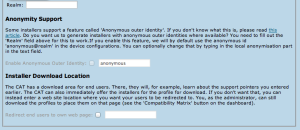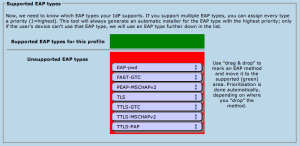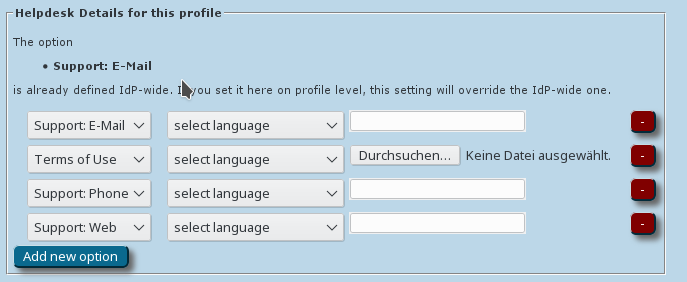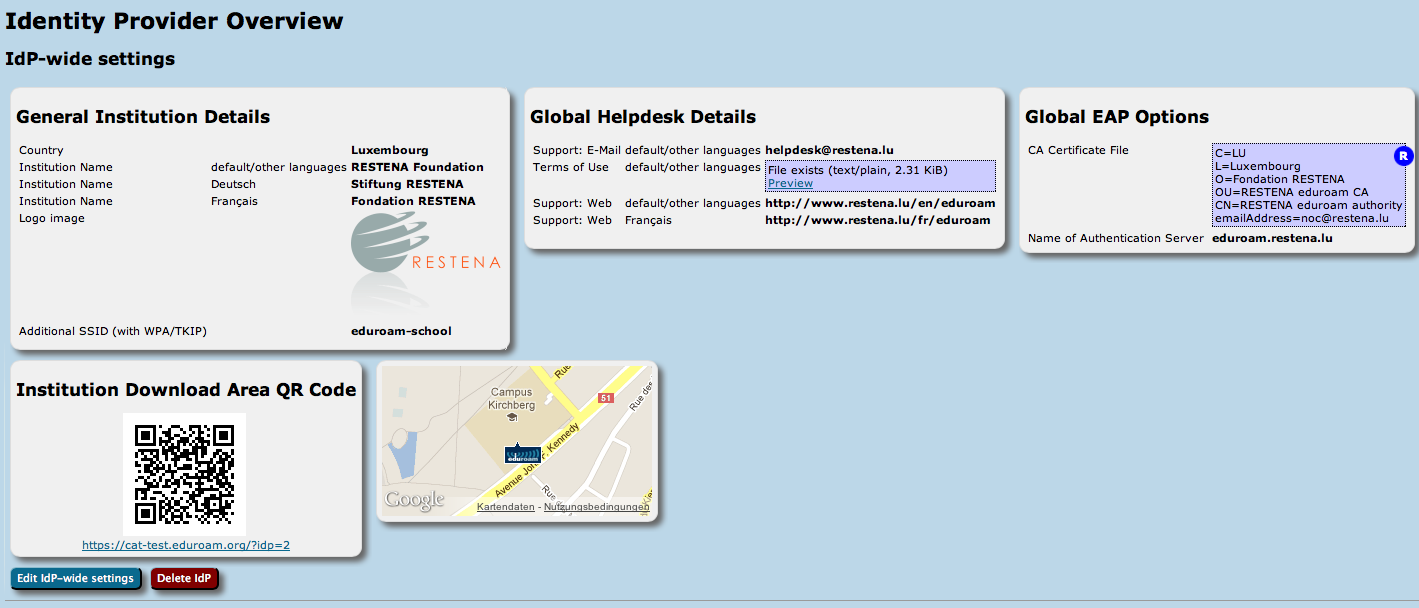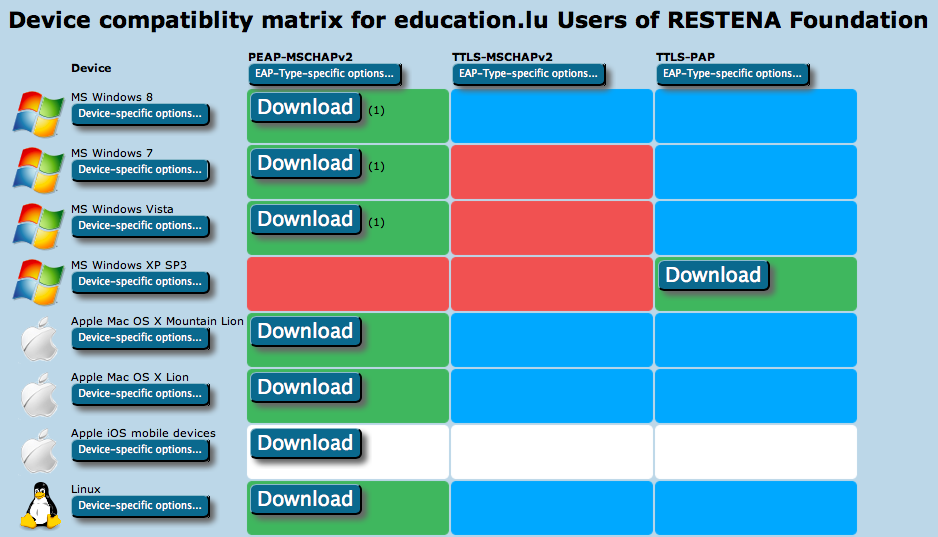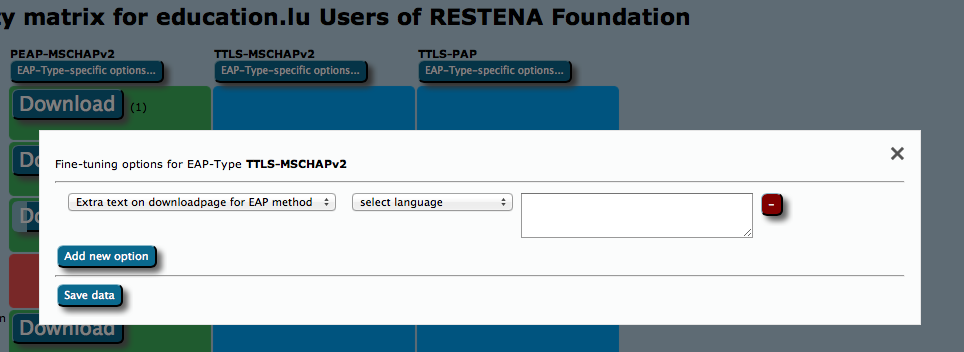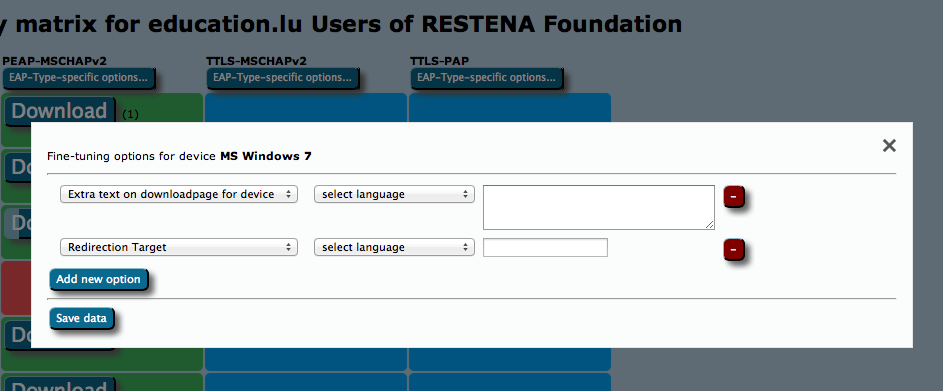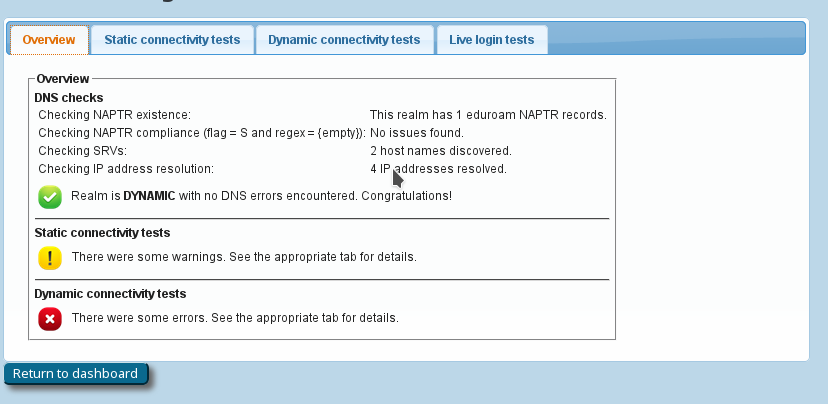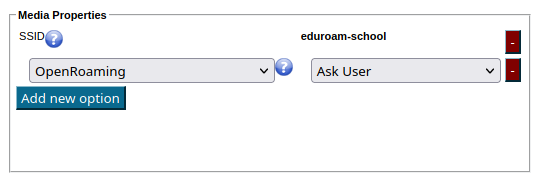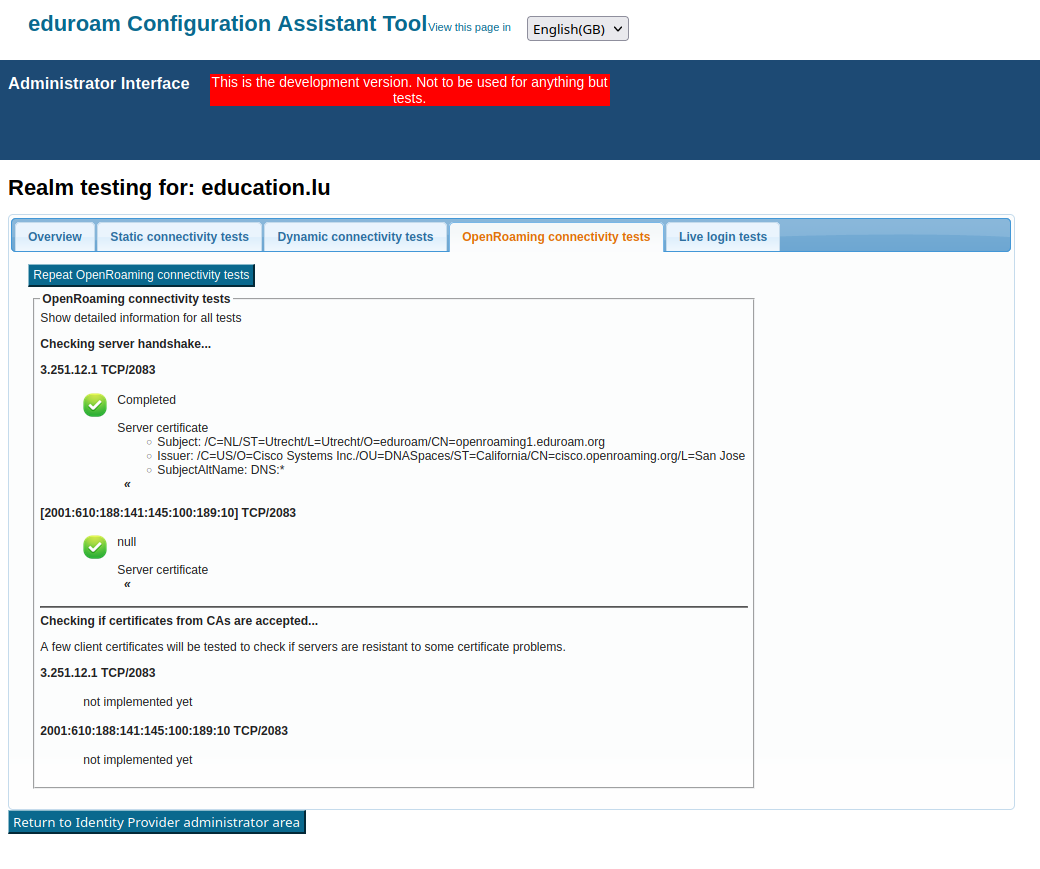| Table of Contents | ||
|---|---|---|
|
eduroam CAT: purpose and scope
Introduction
eduroam CAT is the eduroam Configuration Assistant Tool. Its purpose is to support you, an eduroam Identity Provider administrator, by allowing you to generate customised eduroam installers for various platforms. The customisation includes your IdP's name, location and logo, contact details for your helpdesk, and of course the RADIUS settings which users need to uniquely identify your IdP when roaming. The installers can be produced in many languages; that way, you can even offer your users an installer in their native language! Further to that, eduroam CAT can also assist you in debugging your own RADIUS setup by comparing your inputs to the actual behaviour of your setup in the eduroam infrastructure.
...
Surprisingly many users do not have a clue which operating system they are using. eduroam CAT thus includes an operating system detection and automatically suggests the fitting download. There is a "All platforms" link which takes users to the full platform selection if they so wish. A screenshot of the download area is below. Try it out yourself: hop over to https://cat.eduroam.org, and select any organisation on the download page!
...
There is also a lightweight download page for resource-contrained mobile devices. It also includes the operating system detection.
Device Support
eduroam CAT supports a broad selection of common end-user client devices and many EAP types.To view the full compatibility matrix of supported EAP types and devices, please visit the frontpage of eduroam CAT and click on "About eduroam CAT" on the left-hand side. You will see that not all EAP types are supported on all platforms - we largely rely on the target Operating System's capabilities.
...
Notably, Android versions below 4.3 are not supported and likely never will be, sorry. Your helpdesk will have to take care of legacy Android users by other means.
Support Policy for operating systems versions
eduroam CAT generally tries to follow vendors' end of life dates:
- Microsoft products:http://windows.microsoft.com/en-us/windows/lifecycle
(next to go away: Windows Vista on April 11, 2017) - Apple products: https://support.apple.com/en-gb/HT201624(next to go away, estimated: iPad - 1st gen (2016?), iPod touch - 3rd gen (2018?), iPhone - 4 (20XX?)
TTLS Support for Windows XP, Vista, and 7
...
- ChromeOS products: https://support.google.com/chrome/a/answer/6220366
- Android products: there is no clear support strategy that could be linked against. Status as of Oct 2021 is that apparently Android 8.1 AOSP is the oldest that still receives security updates.
Scope
eduroam CAT is not replacing your helpdesk! While we hope to do you a good service by taking the technical task of generating secure installers for many platforms into our hands, we can not take your users' phone calls or tell them how to fix problems on their computers. The CAT's installers work on the target platforms if these have not been modified beyond reason by the end-user, and we hope the installation process with them is intuitive enough; but we can not give you guarantees that you will not ever hear from failing users again.
Enrolling my institution for eduroam CAT
Step 1: Requesting an entry for your institution
eduroam CAT follows the usual organizational model of eduroam: your national federation administrator has control over all the Identity Providers in his country. To manage your institution with eduroam CAT, please let your national administrator know that you want to participate using your usual communications channels.
If he finds you eligible for the service, he will send you an invitation email with a token (the token is valid for 24 hours after sending it to you). You can then follow the supplied link with the token, log into the eduroam Administration interface, and start managing your institution - see the next section for details of institution and profile setup.
Step 2: How to log into eduroam CAT?
When clicking on the Administration interface link, you Under the Manage Tab, go into eduroam admin access, you will be automatically sent to the eduroam Support Services' federated login service. This login service does not work with site-specific usernames and passwords; , instead you are presented with a list of sources of identity. Choose any organization that you have an account with:
* eduGAIN: many universities across Europe have already joined the educational Global Authorisation INfrastructure - if your organization is among them, click on that institution and authenticate with your home organization's usual web login credentials
* Experimental: some institutions are in the process of joining eduGAIN, but are not production-level members; if that is the case for your institution, you might find your institution's authentication service in this Experimental list
* Social Networks: if you cannot log in with your institution's credentials (for example, because your institution is not participating in eduGAIN), you can also log in using the federated login function of several popular social networks, including, but not limited to, Google and Facebook.
Some users have noted that none of the above options suits them: e.g. their institution is not participating in eduGAIN, and they have an aversion against using social networks. We understand that if a user finds all the numerous authentication options unacceptable, then he will have a hard time logging in. However, at this moment we do not have a good solution to that problem. It might be worth considering creating a social network account just for the purpose of logging in here; even if the service portfolio offered by e.g. Google is not interesting for the user, their authentication service in itself is useful on its own.
Configuring my institution's properties
Overview
There are basically four groups of information which we need to ask of you before we can create good-looking installers for you:
- general information about your institution (e.g. logo, approximate location, name)
- helpdesk contact details (mail, phone, web)
- media properties (e.g. SSIDs, wired support)
- RADIUS and EAP details
- Textual information can be provided in many languages; one language representation should be set as the default language though - to have a string to present to users who want to use a language which wasn't explicitly configured.
- An institution consists of one of more EAP profiles, each of which can have its own EAP-specific settings. One typical use-case is an institution which has "student" and "staff" accounts with different EAP-Types being supported. Many options in eduroam CAT can either be set for the entire institution or only for a specific profile; if a setting is set on both levels, the more specific profile-level setting will override the institution-level one.
Institution-wide Settings
After you've followed the invitation token from your national administrator, you'll be dropped right in the "Edit IdP" page. On that first time, you'll see a "wizard mode" which provides lots of explanatory text about the meaning of all the settings you can make. You can add and delete any of those options; don't be shy and try them all out! Adding a new option is done by pushing the corresponding button, selecting which option you want to set, and then the content of that new option. Changes will only be saved when you hit the "Continue ..." button on the bottom of the page.
When you re-visit the "Edit IdP" page later from the Institution Overview page, the explanatory texts are condensed in order not to overload the user interface. You'll certainly find your way around without the wizard texts.
You can configure three of the four areas mentioned above in this first page. The RADIUS and EAP settings are configured in the more specific Profile configuration at a later stage.
General Information
Helpdesk Contact Details
Media Properties
Here, you can now configure all media properties of your eduroam setup.
The SSID "eduroam" for WPA2/AES is always configured as it is the core of the eduroam specification; you do not need to enter this one here (previous versions of eduroam CAT also installed a WPA/TKIP profile; since these are meanwhile obsolete, current CAT installers will silently remove this profile if seen during installation). The list of things you can additionally configure in "Media" are:
- additional SSID for WPA2/AES:
If you deploy other SSIDs for which eduroam credentials are valid, you can add these here and they will be configured alongside the eduroam SSID. - additional SSID for WPA2/AES and WPA/TKIP
If you deploy other SSIDs for which eduroam credentials are valid, you can add these here and they will be configured alongside the eduroam SSID. This SSID will be installed for both WPA2/AES and (legacy) WPA/TKIP. - additional own Hotspot 2.0 / Passpoint Consortium OI
If you want to enable Passpoint and have a Consortium Organization Identifier, you can enter it here. The consortium OI for eduroam is 001BC50460. We do not currently enable this consortium OI by default.
On end-user device side, settings made regarding Passpoint will currently only benefit the most recent Apple devices (iOS 7+ and recent-enough hardware; recent Mac OS X). - whether or not to configure wired ethernet for IEEE 802.1X
Some eduroam participants also use IEEE 802.1X for wired ethernet ports in their premises, e.g. in dormitories. Administrators can specify that the installers should include wired ethernet eduroam configuration on the client devices. This is currently supported for the Windows installers and Apple OS X. Windows installers will provoke a UAC prompt when wired support is turned on. - disable captive portal SSIDs after setting up eduroam
Many eduroam participants deploy several SSIDs; typically, a captive portal SSID for help and/or download of configuration profiles/configuration instructions (a "bootstrap" or "onboarding" network), and the real eduroam network. If your users have connected to the bootstrap network before, their devices usually remember it, and may unfortunately prefer that network over the then-configured eduroam network. To prevent this, you can configure the name of your bootstrap SSID, and then during the installation process, CAT will either remove it from the client device, or at least mark it as "do not join automatically".
Profiles
Profiles are the specific EAP configurations for your user group(s), and installers are always generated for specific profiles. If you only have one user group, the distinction between institution-wide and profile-wide settings does not make a difference. However, many IdPs have different user groups which share some properties, but not all. One example is where on the one hand students have username/password accounts, authenticating with PEAP and generic helpdesk contact points, and on the other hand permanent staff have TLS Client certificates with EAP-TLS and access to a better second-level helpdesk just for them.
eduroam CAT makes it easy to manage multiple user group profiles for one institution. Shared properties for e.g. server certificates and helpdesk contacts can be defined institution-wide (which makes them immediately available in all profiles) or per-profile (the property then is only defined for this specific profile). You can also define institution-wide settings and override them in specific profiles.
In the first-time wizard, the CAT automatically takes you to the profile creation page as soon as the institution-wide settings are submitted.
For a profile, you first have to set its name and description, which as usually can be done in many languages. There is also one important option: "Production-Ready". We will not publish your generated installers on the end-user download page unless you set this option and check the box. This is to prevent that people accidently download installers with incomplete information while you are still working on the final setup.
The CAT also asks for the RADIUS realm belonging to this profile; submitting the realm name is optional, but highly recommended because it enables us to do very thorough sanity checks on your RADIUS installation later. Please see the section "Verifying my RADIUS setup" for more details. You can also decide whether you want the generated installers to be configured with an anonymous outer identity, and what that identity should be. If you want users of that profile NOT to be given an installer, you can also specify that we should send your users to your own support page instead. A typical use case for that is if you, the admin, want to generate installers but only download them yourself and present them on your own eduroam support page.
The third part of profile generation is about the EAP types which you've configured in your RADIUS server for this user group. By simple drag&drop, please drag all the EAP types you support into the upper green area. The list is ordered by preference, so drag the EAP types into your preferred order. The CAT will always compare the EAP types you've configured here with the capabilities of the various devices which are to be configured. If the device supports your most preferred EAP type, installers will always be generated for that EAP type. If your preferred EAP type does not work on a given device, the preference list is worked through until a match occurs, and then installers for that device will use that not-so-preferred EAP type (which is better than not supporting eduroam configuration at all). Finally, if there is a complete mismatch between the EAP types you support and the EAP types on a device, then we can't generate installers for that device. You might be luckier if you can change your RADIUS setup to support more EAP types then.
EAP Details
In the EAP Details section, you can upload common properties of your RADIUS installation's EAP configuration. If you specify something here, the settings will be used for all the user profiles you define (see below), unless you choose to override them in one of the profiles.
For most EAP methods, the required EAP details are
- The Certification Authority (CA) certificate(s) which signed your EAP server certificate
- always include the root CA (root CAs are indicated with a blue circled "R" besides the certificate details after upload)
- optionally include intermediate CAs (intermediate or server certificates are indicated with a blue circled ("I") besides the certficate after upload)
- The name of your server as specified in the Common Name (CN) of your EAP server certificate
Note 1 - server certificates
There is no point in uploading the server certificate itself. The server certificate is sent during the EAP exchange during login time to the client. Contrary to that, the CA certificates are needed because they are the trust anchor on the client device which it uses to verify that incoming server certificate.
Note 2 - CA requirements
Various client device operating systems have specific requirements about which CA certificates and server certificates they accept. For more information, please see EAP Server Certificate considerations.
Note 3 - CA rollover support
You can upload multiple root CA certificates simultaneously to CAT. On all supported client OSes, all of them will be installed and all will be marked trusted. This enables CA vertificate rollow without a flag day: User devices which were configured with an upcoming new root CA ahead of time will then not even notice the change of server cert from old to new trust root (so long as the Common Name of the server certificate remains unchanged during the rollover).
Almost all CAT-support client operating systems support mutliple trust roots. There is only one fraction of CAT-supported client OSes which does not support multiple root CAs: Android versions < 7.1. For those, due to an API limitation we are not able to do anything about, only one root CA will be installed; the API also cannot install any intermediate CAs at all. To isolate Android users while giving everyone else multiple trust roots early, you could create a different profile (see next section) just for Android and only load the desired root CA into that profile). Android 7.1 finally got its support for multiple trust roots; the eduroamCAT app will support that in a future update.
Given the update situation on the Android platform, it is naive to think that the unsupported root CA rollover problem will wither out in anything less than five years. There is unfortunately nothing we can do about it.
Overriding IdP-wide Settings
After these steps, you can enter/override helpdesk and media properties if you haven't done so on the institution-wide settings already (see above). If you have entered one specific option institution-wide already, and you enter something else here, then the settings on profile level supersede the institution-level ones.
.
- Attributes needed for an R&E federated sign in to eduroam CAT may be one of the following:
- eduPersonTargetedID, Subject-id, Pairwise-id.
- All three are accepted, with no one attribute preferred over another at this time.
- The attributes are checked for presence (and used when a value is found) in this order: eduPersonTargetedID, pairwise-id, subject-id.
- For guidance on enabling these attribute(s) released or transitioning from one unique identifier to another should consult with your National Roaming Operator and/or IdP software provider.
* Experimental: some institutions are in the process of joining eduGAIN, but are not production-level members; if that is the case for your institution, you might find your institution's authentication service in this Experimental list
* Social Networks: if you cannot log in with your institution's credentials (for example, because your institution is not participating in eduGAIN), you can also log in using the federated login function of several popular social networks, including, but not limited to, Google and Facebook.
Some users have noted that none of the above options suits them: e.g. their institution is not participating in eduGAIN, and they have an aversion against using social networks. We understand that if a user finds all the numerous authentication options unacceptable, then he will have a hard time logging in. However, at this moment we do not have a good solution to that problem. It might be worth considering creating a social network account just for the purpose of logging in here; even if the service portfolio offered by e.g. Google is not interesting for the user, their authentication service in itself is useful on its own.
Configuring my institution's properties
Overview
There are basically four groups of information which we need to ask of you before we can create good-looking installers for you:
* general information about your institution (e.g. logo, approximate location, name)
* helpdesk contact details (mail, phone, web)
* media properties (e.g. SSIDs, wired support)
* RADIUS and EAP details
- Textual information can be provided in many languages; one language representation should be set as the default language though - to have a string to present to users who want to use a language which wasn't explicitly configured.
- An institution consists of one of more EAP profiles, each of which can have its own EAP-specific settings. One typical use-case is an institution which has "student" and "staff" accounts with different EAP-Types being supported. Many options in eduroam CAT can either be set for the entire institution or only for a specific profile; if a setting is set on both levels, the more specific profile-level setting will override the institution-level one.
Institution-wide Settings
After you've followed the invitation token from your national administrator, you'll be dropped right in the "Edit IdP" page. On that first time, you'll see a "wizard mode" which provides lots of explanatory text about the meaning of all the settings you can make. You can add and delete any of those options; don't be shy and try them all out! Adding a new option is done by pushing the corresponding button, selecting which option you want to set, and then the content of that new option. Changes will only be saved when you hit the "Continue ..." button on the bottom of the page.
When you re-visit the "Edit IdP" page later from the Institution Overview page, the explanatory texts are condensed in order not to overload the user interface. You'll certainly find your way around without the wizard texts.
You can configure three of the four areas mentioned above in this first page. The RADIUS and EAP settings are configured in the more specific Profile configuration at a later stage.
General Information
Helpdesk Contact Details
Media Properties
Here, you can now configure all media properties of your eduroam setup.
The SSID "eduroam" for WPA2/AES is always configured as it is the core of the eduroam specification; you do not need to enter this one here (previous versions of eduroam CAT also installed a WPA/TKIP profile; since these are meanwhile obsolete, current CAT installers will silently remove this profile if seen during installation). The list of things you can additionally configure in "Media" are:
- additional SSID for WPA2/AES:
If you deploy other SSIDs for which eduroam credentials are valid, you can add these here and they will be configured alongside the eduroam SSID. - additional SSID for WPA2/AES and WPA/TKIP
If you deploy other SSIDs for which eduroam credentials are valid, you can add these here and they will be configured alongside the eduroam SSID. This SSID will be installed for both WPA2/AES and (legacy) WPA/TKIP. - additional own Hotspot 2.0 / Passpoint Consortium OI
If you want to enable Passpoint and have a Consortium Organization Identifier, you can enter it here. The consortium OI for eduroam is 001BC50460. We do not currently enable this consortium OI by default.
On end-user device side, settings made regarding Passpoint will currently only benefit the most recent Apple devices (iOS 7+ and recent-enough hardware; recent Mac OS X). - whether or not to configure wired ethernet for IEEE 802.1X
Some eduroam participants also use IEEE 802.1X for wired ethernet ports in their premises, e.g. in dormitories. Administrators can specify that the installers should include wired ethernet eduroam configuration on the client devices. This is currently supported for the Windows installers and Apple OS X. Windows installers will provoke a UAC prompt when wired support is turned on. - disable captive portal SSIDs after setting up eduroam
Many eduroam participants deploy several SSIDs; typically, a captive portal SSID for help and/or download of configuration profiles/configuration instructions (a "bootstrap" or "onboarding" network), and the real eduroam network. If your users have connected to the bootstrap network before, their devices usually remember it, and may unfortunately prefer that network over the then-configured eduroam network. To prevent this, you can configure the name of your bootstrap SSID, and then during the installation process, CAT will either remove it from the client device, or at least mark it as "do not join automatically".
Profiles
Profiles are the specific EAP configurations for your user group(s), and installers are always generated for specific profiles. If you only have one user group, the distinction between institution-wide and profile-wide settings does not make a difference. However, many IdPs have different user groups which share some properties, but not all. One example is where on the one hand students have username/password accounts, authenticating with PEAP and generic helpdesk contact points, and on the other hand permanent staff have TLS Client certificates with EAP-TLS and access to a better second-level helpdesk just for them.
eduroam CAT makes it easy to manage multiple user group profiles for one institution. Shared properties for e.g. server certificates and helpdesk contacts can be defined institution-wide (which makes them immediately available in all profiles) or per-profile (the property then is only defined for this specific profile). You can also define institution-wide settings and override them in specific profiles.
In the first-time wizard, the CAT automatically takes you to the profile creation page as soon as the institution-wide settings are submitted.
For a profile, you first have to set its name and description, which as usually can be done in many languages. There is also one important option: "Production-Ready". We will not publish your generated installers on the end-user download page unless you set this option and check the box. This is to prevent that people accidently download installers with incomplete information while you are still working on the final setup.
The CAT also asks for the RADIUS realm belonging to this profile; submitting the realm name is optional, but highly recommended because it enables us to do very thorough sanity checks on your RADIUS installation later. Please see the section "Verifying my RADIUS setup" for more details. You can also decide whether you want the generated installers to be configured with an anonymous outer identity, and what that identity should be. If you want users of that profile NOT to be given an installer, you can also specify that we should send your users to your own support page instead. A typical use case for that is if you, the admin, want to generate installers but only download them yourself and present them on your own eduroam support page.
The third part of profile generation is about the EAP types which you've configured in your RADIUS server for this user group. By simple drag&drop, please drag all the EAP types you support into the upper green area. The list is ordered by preference, so drag the EAP types into your preferred order. The CAT will always compare the EAP types you've configured here with the capabilities of the various devices which are to be configured. If the device supports your most preferred EAP type, installers will always be generated for that EAP type. If your preferred EAP type does not work on a given device, the preference list is worked through until a match occurs, and then installers for that device will use that not-so-preferred EAP type (which is better than not supporting eduroam configuration at all). Finally, if there is a complete mismatch between the EAP types you support and the EAP types on a device, then we can't generate installers for that device. You might be luckier if you can change your RADIUS setup to support more EAP types then.
EAP Details
In the EAP Details section, you can upload common properties of your RADIUS installation's EAP configuration. If you specify something here, the settings will be used for all the user profiles you define (see below), unless you choose to override them in one of the profiles.
For most EAP methods, the required EAP details are
- The Certification Authority (CA) certificate(s) which signed your EAP server certificate
- always include the root CA (root CAs are indicated with a blue circled "R" besides the certificate details after upload)
- optionally include intermediate CAs (intermediate or server certificates are indicated with a blue circled ("I") besides the certficate after upload)
- The name of your server as specified in the Common Name (CN) of your EAP server certificate
Note 1 - server certificates
There is no point in uploading the server certificate itself. The server certificate is sent during the EAP exchange during login time to the client. Contrary to that, the CA certificates are needed because they are the trust anchor on the client device which it uses to verify that incoming server certificate.
Note 2 - CA requirements
Various client device operating systems have specific requirements about which CA certificates and server certificates they accept. For more information, please see EAP Server Certificate considerations.
Note 3 - CA rollover support
You can upload multiple root CA certificates simultaneously to CAT. This enables CA certificate rollover without a flag day: User devices which were configured with an upcoming new root CA ahead of time will then not even notice the change of server cert from old to new trust root (so long as the Common Name of the server certificate remains unchanged during the rollover).
On the client OSes, all root CAs will be installed and all will be marked trusted. The eduroam CAT Android App, however, will only install one certificate and can thus not be used to support CA rollover. Please use the geteduroam App instead. Or you can isolate Android users while giving everyone else multiple trust roots early, in this case you can create a different profile (see next section) just for Android and only load the desired root CA into that profile.
Overriding IdP-wide Settings
After these steps, you can enter/override helpdesk and media properties if you haven't done so on the institution-wide settings already (see above). If you have entered one specific option institution-wide already, and you enter something else here, then the settings on profile level supersede the institution-level ones.
That's all - That's all - the CAT then proceeds to a sanity check of the things you have configured and will tell you about any things which need fixing, it any. You are then transported to the Institution dashboard - from where you can continue to download your installers, change institution or profile details, perform sanity checks and more.
Generating installers for my users
On the institution dashboard page, you see the most important pieces of data that you have entered.
This data (and all profile-specific data) is used to create installers from. To actually get access to the installers, click on the "Installer Fine-Tuning and Download" button in your defined profile.
This will take you to the overview of available installers. It takes the form of a matrix of your enabled EAP types, the devices CAT knows about, and whether or not an installer for all the combinations is available.
- Green matrix entries mean that the installer is ready for use, and there is a Download button in these fields.
- Blue entries mean that CAT could create an installer for that combination, but there is a more highly preferred EAP type which it can serve as well; so that one is generated instead.
- Red entries mean that CAT does not know how to configure the EAP type on that device.
- Grey entries mean that you did not supply all required information for CAT to produce an installer for you - you would need to go back to IdP and/or Profile settings and fill in the missing pieces.
- White entries mean that you have set up an "exception" and CAT will not offer this combination to end-users, even if an installer may in principle be available (see next paragraph for details).
Maybe you have something special to communicate to your users? E.g. hints which password to use for EAP-TTLS, or which secretariat to turn to to get the client certificate for EAP-TLS? Maybe you ban Apple Smartphones from your campus and want to alert users to that end?
For all these options, the Fine-Tuning page has extra buttons: you can add free-text for either specific EAP Types or specific devices. This text will then be displayed on the user download page before the download begins. For devices, you can also specify a Redirect target; if this is set, CAT will not provide a download button, but instead will redirect users to the URL you specified. This could, for example, be useful if you have a custom-made or commercial installer for one of the devices, and don't want to use CATs services for that device. If this option is set, the background for this device will turn white in the matrix (see screenshot above).
You can now push the download buttons and use the generated installers as you see fit. This is also possible for redirected devices; even though your users don't get this installer from CAT, you as an admin might want to have it anyway, e.g. to include it in your own eduroam support pages.
Installer visibility on the user download page
You are in full control which of the installers, if any, and when you want to show on the CAT end-user download pages. Your control options are as follows:
- Make the EAP profile visible, but redirect users to your own support pages (entry is listed, but no download on the public page). This can be set in Profile options - see screenshot.
- Make the EAP profile visible with installers, but redirect certain devices to your own pages. Use the Fine-Tuning matrix to set the Redirect option for the device (see previous section).
- Make all installers visible.
All of three options will require confirmation by you that you have entered all details and have reviewed the profile to be "production-ready". No details of your EAP deployment will be made visible until you have declared your data set production-ready. You do this by adding the option with that same name in your Profile properties.
The visibility status of your EAP deployment is indicated with either a green (published) or yellow (unpublished) status icon on the Profile info (see screenshot). If the status is yellow, you can hover with your mouse over it to get a more detailed explanation why the profile is not published.
Verifying my RADIUS setup
If you have supplied the CAT with the realm which you are using in eduroam, an extra service is enabled for you: the CAT can send live data probes through the eduroam infrastructure to see if your realm's RADIUS server is reachable and whether it passes various sanity checks. All these tests are triggered by pushing the button "Check realm reachability". You will be presented with an overview page immediately while various tests are executed in the background:
The tests will take a few to several tens of seconds, and will give you an in-depth overview of how your RADIUS server is doing in the world of eduroam. The tests include
...
- Authentication round-trip times to your realm which take more than 5 seconds are suspicious
- Your server must be able to send and receive UDP fragments (some firewalls choke on that)
- There are a number of RADIUS attributes that are commonly present in authentication requests; some servers behave strangely on receipt - we'll let you know if yours is problematic
- Checks regarding the structure and validity of your server, intermediate and root CA certificates. These checks are as thorough as checking everything that is described in prose on the EAP Server Considerations page. Here is a typical output if your server certificate is "from the 1990s" (i.e. didn't keep up with all the recommendations and requirements on server certificates in recent years):
Optional: OpenRoaming support
OpenRoaming is a Wi-Fi roaming consortium independent from eduroam, but using similar underlying technologies. You can find more details about this consortium and eduroam's interaction, and information for eduroam end users.
eduroam has created infrastructure that allows eduroam IdPs to enable their end-users for joining OpenRoaming hotspots. This
- has to be enabled by your NRO for your country or region
- is entirely optional for you as an IdP
- requires actual work in your own domain's DNS setup to function correctly
- is currently in its early days and functionality varies between EAP types and operating systems
General information and details about the technical setup can be found at Roaming on Passpoint-based network infrastructure (incl. OpenRoaming) (notably the "eduroam IdP" section there). Only the CAT-specific steps are described below:
Enabling OpenRoaming with CAT 2.1+
Starting with version 2.1, the eduroam onboarding toolset (eduroam CAT and eduroam Managed IdP) integrates Passpoint network definitions in general, and OpenRoaming settings in particular, in its standard workflow. You can enable OpenRoaming by setting the option of that name in the "Media Properties" section:
If you do not see this option, then your National Roaming Operator (NRO) did not enable the functionality in their country or region yet. Please speak to your NRO in that case.
This option can have one out of four states. This is due to two choices you have to make about OpenRoaming inclusion into installers:
1) Do you want to give every end user the choice to decide whether they want to join OpenRoaming networks?
2) Do you inform your end users about the OpenRoaming Terms and Conditions yourself out-of-band, or should this be done by CAT?
Unsurprisingly, this maps to the four choices and end-user download interface:
| Option Value | Meaning | End-User download interface |
|---|---|---|
| Ask User | User is asked to make a choice; OpenRoaming Terms and Conditions have to be acknowledged during the download process | two buttons and a "Accept T&C" checkbox |
| Ask User; T&C Pre-Agreed | User is asked to make a choice; no need to acknowledge OpenRoaming Terms and Conditions explicitly because this has been done by the IdP | two buttons ("eduroam" and "eduroam and OpenRoaming") |
| Always | All users always gets an eduroam + OpenRoaming installer, but have to acknowledge the OpenRoaming Terms and Conditions during the download process | one button and a "Accept T&C" checkbox |
| Always; T&C Pre-Agreed | All users always get an eduroam + OpenRoaming installer, no need to acknowledge OpenRoaming Terms and Conditions because this has been done by the IdP | one button ("eduroam and OpenRoaming") |
| (not set) | no OpenRoaming, just eduroam | one button ("eduroam") |
DNS setup verification
After enabling OpenRoaming, CAT will execute checks that verify whether your RADIUS realm is correctly configured in DNS. You see the results of this check in the Submission Summary page in your enabled profiles. Please attend to all warnings and errors thoroughly to make sure OpenRoaming will actually work for your users in the field.
These checks can be repeated any time using the "Check Realm Reachability" button (see "Verifying my RADIUS Setup" below). The check page has a new tab for the OpenRoaming checks:
Unfortunately, currently IPv6 connectivity tests are not implemented, so you will receive a warning about those. This will be fixed soon (2.1.1 or a hotfix release).
Technical ability to support OpenRoaming in installers
Support is currently limited to the following operating systems:
| OS family | Notes |
|---|---|
| Windows 10+ | Depends on chipset and driver capabilities. If not supported, OpenRoaming will be silently ignored during installation. |
| Apple | CAT native installer (mobileconfig): only works for PEAP and EAP-TLS. The password prompt for OpenRoaming during install is "ugly": geteduroam installer, TTLS support is possible (see extra explanation about geteduroam limits below) |
| Android 8+ | OpenRoaming availability depends on vendor build and chipset support. |
| Android 11+ | supported |
Note on geteduroam and user choice: the in-app workflow only installs OpenRoaming if one the "Always" variants has been selected. If "Ask user" has been selected, geteduroam in-app workflow will only install eduroam, not OpenRoaming. "Ask user" will soon work (2.1.1 or as a hotifx) by downloading the Android installer from the end-user download interface of CAT and an "Open with ... geteduroam" (known as 'side-loading' in geteduroam).
Generating installers for my users
On the institution dashboard page, you see the most important pieces of data that you have entered.
This data (and all profile-specific data) is used to create installers from. To actually get access to the installers, click on the "Installer Fine-Tuning and Download" button in your defined profile.
This will take you to the overview of available installers. It takes the form of a matrix of your enabled EAP types, the devices CAT knows about, and whether or not an installer for all the combinations is available.
- Green matrix entries mean that the installer is ready for use, and there is a Download button in these fields.
- Blue entries mean that CAT could create an installer for that combination, but there is a more highly preferred EAP type which it can serve as well; so that one is generated instead.
- Red entries mean that CAT does not know how to configure the EAP type on that device.
- Grey entries mean that you did not supply all required information for CAT to produce an installer for you - you would need to go back to IdP and/or Profile settings and fill in the missing pieces.
- White entries mean that you have set up an "exception" and CAT will not offer this combination to end-users, even if an installer may in principle be available (see next paragraph for details).
Maybe you have something special to communicate to your users? E.g. hints which password to use for EAP-TTLS, or which secretariat to turn to to get the client certificate for EAP-TLS? Maybe you ban Apple Smartphones from your campus and want to alert users to that end?
For all these options, the Fine-Tuning page has extra buttons: you can add free-text for either specific EAP Types or specific devices. This text will then be displayed on the user download page before the download begins. For devices, you can also specify a Redirect target; if this is set, CAT will not provide a download button, but instead will redirect users to the URL you specified. This could, for example, be useful if you have a custom-made or commercial installer for one of the devices, and don't want to use CATs services for that device. If this option is set, the background for this device will turn white in the matrix (see screenshot above).
You can now push the download buttons and use the generated installers as you see fit. This is also possible for redirected devices; even though your users don't get this installer from CAT, you as an admin might want to have it anyway, e.g. to include it in your own eduroam support pages.
Installer visibility on the user download page
You are in full control which of the installers, if any, and when you want to show on the CAT end-user download pages. Your control options are as follows:
- Make the EAP profile visible, but redirect users to your own support pages (entry is listed, but no download on the public page). This can be set in Profile options - see screenshot.
- Make the EAP profile visible with installers, but redirect certain devices to your own pages. Use the Fine-Tuning matrix to set the Redirect option for the device (see previous section).
- Make all installers visible.
All of three options will require confirmation by you that you have entered all details and have reviewed the profile to be "production-ready". No details of your EAP deployment will be made visible until you have declared your data set production-ready. You do this by adding the option with that same name in your Profile properties.
The visibility status of your EAP deployment is indicated with either a green (published) or yellow (unpublished) status icon on the Profile info (see screenshot). If the status is yellow, you can hover with your mouse over it to get a more detailed explanation why the profile is not published.
Verifying my RADIUS setup
If you have supplied the CAT with the realm which you are using in eduroam, an extra service is enabled for you: the CAT can send live data probes through the eduroam infrastructure to see if your realm's RADIUS server is reachable and whether it passes various sanity checks. All these tests are triggered by pushing the button "Check realm reachability". You will be presented with an overview page immediately while various tests are executed in the background:
The tests will take a few to several tens of seconds, and will give you an in-depth overview of how your RADIUS server is doing in the world of eduroam. The tests include
- a DNS check whether your realm is publishing NAPTR records for eduroam Dynamic Discovery; and if so, whether all DNS records are correct (if you don't know what Dynamic Discovery is, please talk to your national federation operator. It's cool!). If the DNS checks were successful, the CAT will make actual use of the discovered RADIUS Dynamic Discovery server targets and try to connect. It will present a mix of valid and invalid certificates and will check whether the server acted correctly on receipt of these certificates.
- the results of actual authentication tests which were sent in the moment you pushed the button: these will not log anybody in (we don't have actual user credentials) but even with the planned failed authentication, we can run lots of diagnosis on your server. The web page will let you know if we found some oddities you might want to take care of:
- Authentication round-trip times to your realm which take more than 5 seconds are suspicious
- Your server must be able to send and receive UDP fragments (some firewalls choke on that)
- There are a number of RADIUS attributes that are commonly present in authentication requests; some servers behave strangely on receipt - we'll let you know if yours is problematic
- Checks regarding the structure and validity of your server, intermediate and root CA certificates. These checks are as thorough as checking everything that is described in prose on the EAP Server Considerations page. Here is a typical output if your server certificate is "from the 1990s" (i.e. didn't keep up with all the recommendations and requirements on server certificates in recent years):
- If you feel comfortable giving CAT access to short-lived real authentication credentials (for debugging purposes with test user accounts only!), then you can run an actual positive authentication test; in which case we can run even more diagnosis.
Other features
User API
A full access WEB API makes it possible to create different user interfaces to CAT. In particular you can list countries with configured institutions, list institutions globally or within a country, list profiles within institution, ask for the institution logo or even geolocate users's IP address and, of course download installers for given user profiles and devices.
Silent Windows installers
CAT 1.1 Windows installers can be run silently with the /S flag, which is useful for institutions which want to build the installers into their own, larger ones.
Replacing the RADIUS server root CA certificate
When your RADIUS server's root CA certificate is about to expire and you need to replace it with a new one, the new CA certificate needs to be communicated to all your users' devices. The procedure to achieve this is as follows:
1. Create a new “migration” eduroam profile in eduroam CAT, containing both the current and new root CA certificates. All previous eduroam CAT profiles should be deleted to avoid them being used. (Caveat: this new profile will not work as intended for Android < 7.1 devices).
2. Require all new and existing end-users to download the “migration” profile. Their devices, except for Android < 7.1, will then be capable of trusting both the current and the new CA, and will accept server certificates from either CA.
3. Once you are confident that all end-user devices have the “migration” profile installed, apply the new server certificate on the Radius server(s). Ideally, the host name in the certificate CN/subjectAltNames should be identical to the old server certificate. (Caveat: Android < 7.1 devices configured with the old root CA will now no longer be able to authenticate, they will need to install a new profile containing just the new root CA).
4. Create a new “permanent” eduroam profile in eduroam CAT, containing only the new root CA certificate. Delete the “migration” eduroam profile.
5. Require all existing Android < 7.1 users, and all new users, to download the new profile
...
Other features
User API
A full access WEB API makes it possible to create different user interfaces to CAT. In particular you can list countries with configured institutions, list institutions globally or within a country, list profiles within institution, ask for the institution logo or even geolocate users's IP address and, of course download installers for given user profiles and devices.
Silent Windows installers
CAT 1.1 Windows installers can be run silently with the /S flag, which is useful for institutions which want to build the installers into their own, larger ones.
Getting Help with eduroam CAT
If you have any questions about the eduroam CAT website or the underlying software, don't hesitate to ask on the mailing list cat-users@lists.geant.org . If possible, please subscribe to the list before posting; this guarantees that you'll get replies even if someone forgets a "reply to all", and also ensures that your post doesn't accidently get classified as spam and discarded.


